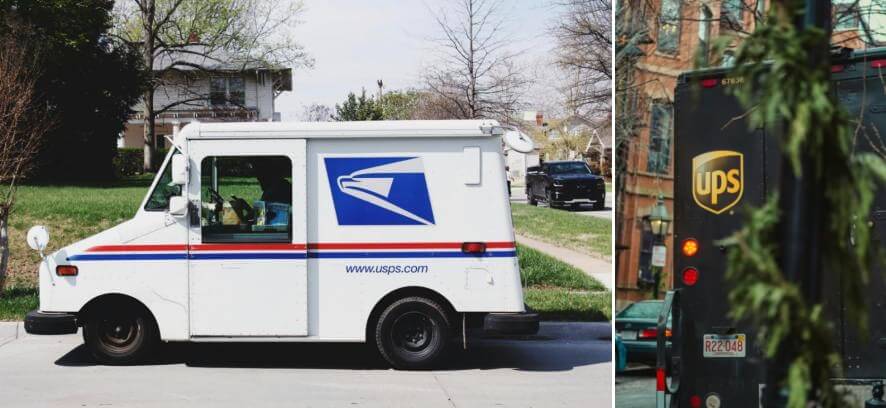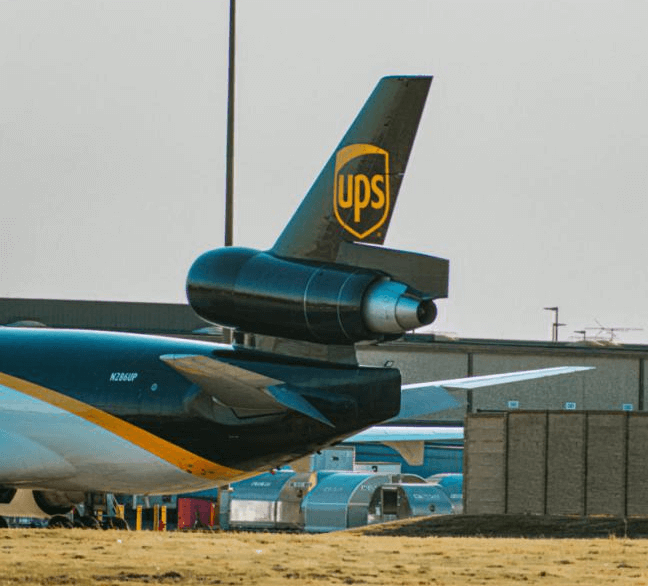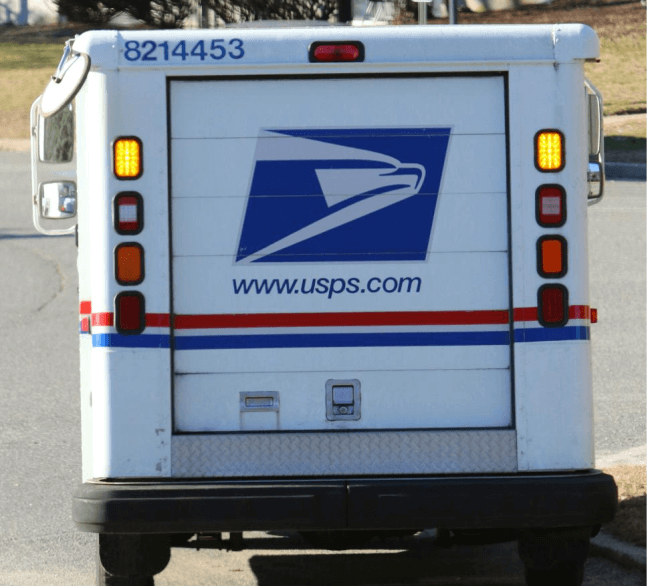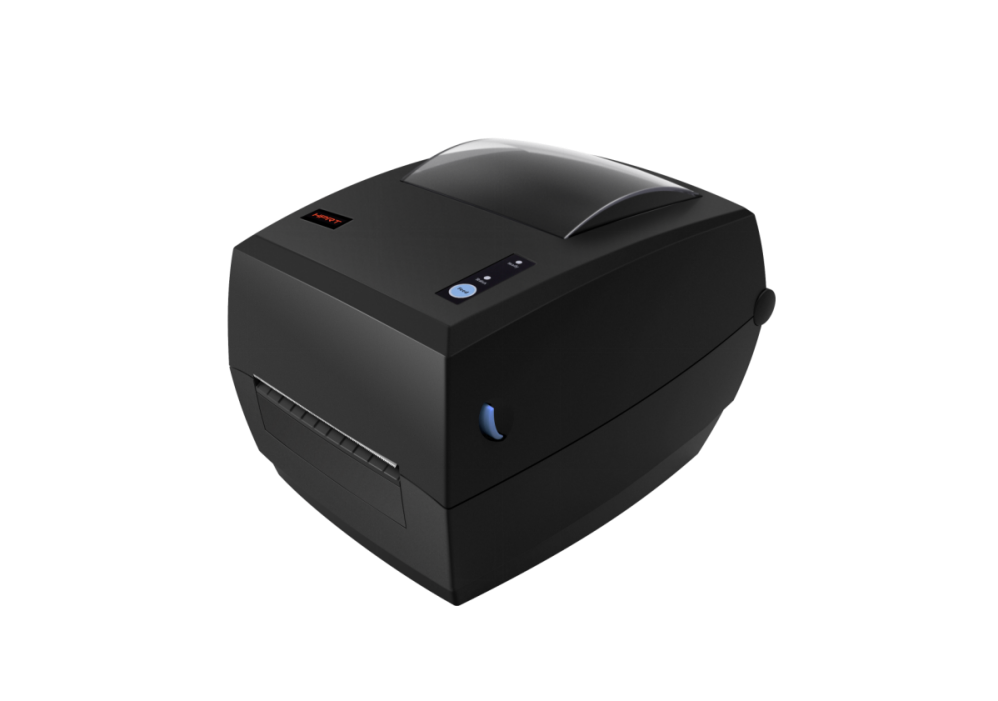


When you need to ship something, speed and reliability aren't optional—they're a must. In the U.S., two names usually pop up: UPS and USPS. They're both trusted and easy to use, but if you're running a small business, selling online, or just trying to get a package delivered on time, which one actually gives you more for your money?
In this guide, we'll break down the real differences—like cost, delivery time, tracking, and international shipping—so you can figure out which one makes the most sense for your needs.

Let's kick things off with a quick side-by-side look at UPS vs. USPS in 2025—so you can easily see what sets them apart.
| Feature | UPS | USPS |
|---|---|---|
| Cost | Higher base rates; better for large/heavy packages | Lower for small/light parcels; great flat-rate options |
| Speed | Ground: 1–5 business days Express: next-day available |
Priority Mail: 1–3 days First-Class: 2–5 days |
| Tracking | Detailed, real-time updates; high reliability | Free basic tracking; less detailed |
| Reliability | Strong for high-value or urgent shipments | Good for lightweight, non-urgent mail |
| International Shipping | Fast but costly; excellent tracking (UPS Worldwide, Express Saver) | Affordable for small items; slower; limited tracking (PMI, EMI) |
| Coverage | Global; remote area surcharges may apply | Covers all U.S. states, territories, APO/FPO without extra fees |
| Best For | Heavy parcels, B2B shipping, express needs | Small eCommerce parcels, cost-saving domestic deliveries |
Next, let's take a closer look at how UPS and USPS stack up across key shipping factors.

UPS started way back in 1907 as a small messenger service in Seattle—just a bicycle, a phone, and a lot of hustle. Since then, it's grown into one of the biggest delivery companies in the world, now serving over 220 countries and territories. Known for fast shipping, solid tracking, and reliable service, UPS is a go-to for businesses that need things to arrive on time, no excuses.

USPS has been around even longer—since 1775, with Benjamin Franklin as the first Postmaster General. These days, it's still a huge part of daily life in the U.S., delivering mail and packages to over 165 million addresses, from big cities to tiny rural towns. As a government-run service, USPS is known for being affordable and for showing up—no matter where you live.
Let's be honest—when you're shipping something, cost is usually the first thing you check. That's especially true if you run a small business or sell stuff online. Generally, USPS is the cheaper pick for lightweight, local deliveries, while UPS can be the better deal for bigger or long-distance shipments.
To help you decide, we've put together a simple comparison table that breaks down the key things to look at—like weight, size, distance, service options, and those sneaky extra fees that can add up fast.
| Service Option | UPS | USPS |
|---|---|---|
| Ground Shipping | ~$16.50 | ~$12.80 (USPS Ground Advantage) |
| 2-Day Delivery | ~$36.00 (UPS 2nd Day Air) | ~$17.10 (USPS Priority Mail) |
| Flat Rate (Medium Box) | ✅ UPS Simple Rate | ✅ $17.10 (Nationwide pricing) |
| Tracking Included | ✅ Yes | ✅ Yes |
| Insurance Included | ❌ No (extra cost) | ✅ Up to $100 (the exact amount may vary depending on the mailing channel; some retail shipments may only include $50) |
Note: Prices are illustrative examples based on early 2025 estimates for a sample package and are subject to change. Always use the official shipping calculator for an exact quote.
Both carriers have base rates—but UPS is more likely to include surcharges, especially for:
| Fee Type | UPS | USPS |
|---|---|---|
| Fuel surcharge | ✅ Yes (variable) | ❌ No |
| Residential delivery fee | ✅ Often applies | ❌ No |
| Saturday delivery fee | ✅ Extra charge in some cases | ❌ Included by default |
| Rural/remote area surcharge | ✅ May apply | ❌ Never applied |
| Dimensional weight pricing | ✅ Applies strictly | ✅ Applies (less aggressively) |
Pro Tip:
Always check the final quote including fees—UPS may look affordable upfront but ends up more expensive after all surcharges are added.
UPS Ground is a ground-based delivery service offered by United Parcel Service (UPS), ideal for heavier packages that don't need overnight delivery.
USPS Priority Mail is a fast domestic service by the United States Postal Service (USPS), offering 1–3 day delivery with Saturday service included.
To make things easier, we've compared the two across key features below.
| Feature | UPS Ground | USPS Priority Mail |
|---|---|---|
| Delivery Time | 1–5 business days (distance-based) | 1–3 business days (nationwide) |
| Weekend Delivery | Available, but usually extra | Saturday delivery included at no extra cost |
| Tracking | Full tracking with estimated delivery time | Full tracking, less precise than UPS |
| Best For | Heavy or high-value items, B2B deliveries | Lightweight packages, time-sensitive items |
| Pricing | Higher base rates; more surcharges | Often cheaper for smaller packages |
For example, you're sending a 2-pound package from New York to Chicago.
With UPS Ground, it might take 3 business days, and delivery could be Monday through Friday only—unless you pay extra for Saturday.
With USPS Priority Mail, that same package will likely arrive in 1 to 2 business days, including Saturday, at a lower cost—especially if it fits in a flat-rate box.
In short, if you're shipping something lightweight and need it fast, USPS Priority is a solid choice. But if it's heavy, valuable, or part of a business order, UPS Ground gives you more structure and control—just be ready to pay a bit more for extras like weekend service.
Nobody wants to deal with a missing shipment—it's not just a logistical headache, but a potential threat to your brand reputation and customer trust. That's why choosing a reliable carrier with strong tracking and on-time delivery performance is essential to delivering a seamless customer experience.
UPS shines with more detailed, near-real-time tracking updates. It also tends to have fewer lost or delayed items. USPS has gotten better with tracking but still lacks the precision of UPS, especially for international or multi-leg shipments.
So, if your package is high-value, fragile, or time-sensitive, UPS is probably the safer bet.
Let's compare for international shipping: USPS or UPS? Let's explore delivery times, pricing, tracking quality, and customs efficiency etc.
| Feature | USPS | UPS |
|---|---|---|
| Service Types | Priority Mail Intl, First-Class Intl, Express Intl | UPS Worldwide Saver, Expedited, Express, Standard (Canada/Mexico) |
| Estimated Delivery | 6–10 days (Priority Intl) 3–5 days (Express Intl) |
1–5 days depending on service and destination |
| Tracking Reliability | Basic; may stop at U.S. border (varies by country) | Strong, end-to-end with real-time updates |
| Customs Handling | Slower; manual forms often required | Faster; electronic commercial invoice system (EDI) |
| Best For | Lightweight, low-value goods; lower budget | High-value, time-sensitive, trackable international shipments |
If you're sending something light—like under 4 pounds—USPS is usually the cheaper pick, especially with First-Class Package International. It's a solid option when you're trying to keep costs low on lightweight stuff headed overseas.
UPS, on the other hand, costs more—but you get what you pay for. It's faster, gives you step-by-step tracking, and tends to breeze through customs, especially if you're shipping electronics or higher-value gear.
| Carrier | Customs Speed | Duties Paid at Checkout? | Paperwork Type |
|---|---|---|---|
| USPS | ❌ Slower (manual) | ❌ Usually paid on delivery | Paper customs forms (CN22/CN23) |
| UPS | ✅ Faster (electronic) | ✅ Prepaid via UPS tools | Electronic Commercial Invoice |
So, when your shipments are regularly delayed due to customs, UPS's automated clearance process is a significant advantage.
eBay/Etsy sellers shipping small handmade items (under 2 kg) → USPS First-Class Intl is most economical.
Dropshippers or brands selling to Europe/Asia → UPS Worldwide Expedited offers better reliability and less delivery dispute risk.
If you're an Etsy seller, run a Shopify store, or dropship for a living, shipping isn't just a cost—it's part of your customer experience.
| Business Type | Recommended Carrier | Why It Works Well |
|---|---|---|
| Etsy handmade shop | ✅ USPS (First-Class & Priority) | Budget-friendly, includes Saturday delivery |
| Shopify/eBay US-based store | ✅ USPS (Domestic) ✅ UPS (International/Heavy) |
Mix of affordability and scalability |
| Amazon seller (FBM model) | ✅ UPS (integrated tools + speed) | Better delivery guarantee and API support |
| Dropshipping business | ✅ UPS (global reach + tracking) | High value items and lower dispute rate |
High-speed and high-performance thermal shipping label printers will save you time and headaches. They are fully compatible with both UPS and USPS, as well as platforms like Shopify, eBay, and offer fast, smudge-free 4"x6" label printing—helping small businesses save time, reduce costly manual errors, and streamline your shipping process.

YOU MAY ALSO LIKE:
At the end of the day, there's no one-size-fits-all answer. But here's a rough guide:
No matter which one you go with, the key is to ship smart. Tools like thermal label printers, shipping calculators, and automation apps can save you a ton of time (and headaches).
Shipping doesn't have to be a hassle. With a little planning, the right carrier, and the right gear, you'll be shipping like a pro in no time—no stress, no drama.
Have a question? We've got answers.
If you're sending small, lightweight stuff around the U.S., USPS usually wins on price. But for heavier boxes—or if you're shipping a lot as a business—UPS can give you better deals, especially if you've got a business account lined up.
USPS Priority Mail is typically quicker, landing in 1–3 days. UPS Ground takes about 1–5 days, depending on how far it's going. So if time's tight, USPS usually gets it there faster.
USPS drops off on Saturdays as part of the deal—no extra charge. UPS? They can deliver on Saturdays, but only in certain areas and usually with an added fee. So, not always a given.
UPS is more on point with tracking—it gives you more detailed updates and tends to hit delivery windows more accurately. USPS tracking is a bit more basic, but it gets the job done for most everyday packages.
Yep, no problem there. Thermal label printers—like the ones from HPRT—handle both UPS and USPS 4"x6" labels just fine. They also plug in easily with tools like ShipStation and Shopify, so you can print and ship without the headache.